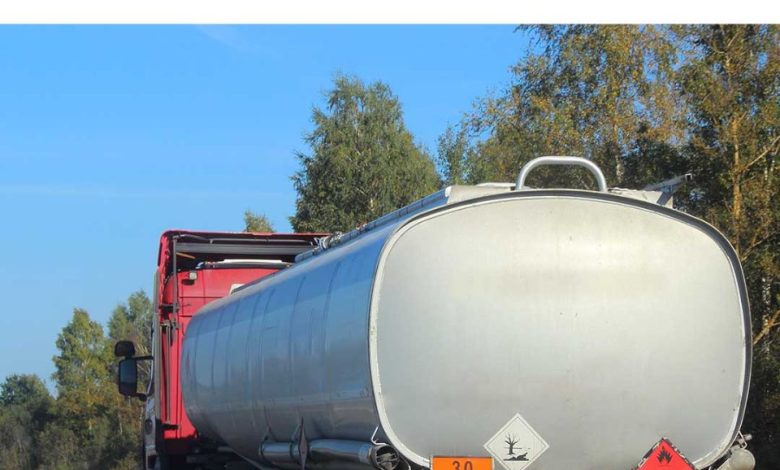Never realized this

Tanker trucks are special vehicles built to carry liquids or gases, like gasoline, water, chemicals, and even liquids used in food. These trucks have a big, round tank attached to a truck frame. This tank is designed to hold and move these materials safely. The design and parts of a tanker truck are very important for making sure the cargo gets where it needs to go safely and efficiently. One thing you might see on a tanker truck is a chain hanging down at the back. This simple chain is actually a very important part of the truck’s safety system.
Why is there a chain hanging on a tanker truck?
That chain is there to get rid of static electricity. When flammable liquids are being transported, they can create static electricity as they move around inside the tank. Think of it like rubbing a balloon on your hair – it makes static. If that static electricity isn’t controlled, it can create sparks. And sparks can be dangerous, especially around flammable liquids. The chain drags on the ground, and this provides a safe path for the static electricity to go into the earth. This stops sparks from happening and helps prevent fires or explosions.
How did the chain become a standard part of tanker trucks?
Grounding chains became common practice as people learned more about the dangers of static electricity when moving fuel. In the past, accidents caused by static discharge were more frequent, leading to terrible fires and explosions. Because of this, safety rules were created to include ways to control static. The grounding chain was a simple but effective answer to this problem. It became a standard part of tanker trucks all over the world. Over time, rules and industry standards have made sure that all tanker trucks have this important safety feature.
What are the safety rules for tanker trucks?
Safety is the most important thing when moving dangerous materials. There are strict rules for tanker trucks. Groups like the Department of Transportation (DOT) in the United States have created guidelines to make sure these trucks are operated safely. These rules cover things like how the tank is built, how much pressure it can handle, and how to control static electricity. The grounding chain is required by these rules, and its condition is often checked during regular inspections. Following these rules is very important to prevent accidents and protect both the people moving the materials and the public.
Why does static electricity happen, and why is it a problem for fuel trucks?
Static electricity is a normal thing that happens when two things touch and then separate. This causes an imbalance of electrical charges. When fuel is moving inside a tanker, it creates static electricity because of friction. This is especially dangerous with flammable liquids, because a static spark can ignite the fumes and cause explosions. The grounding chain provides a way for the static charge to go safely into the ground, preventing dangerous electrical energy from building up. Understanding how static electricity works is very important for creating good safety measures for transporting fuel.
Are there other ways to ground tanker trucks besides the chain?
While grounding chains are a traditional way to get rid of static electricity, modern tanker trucks sometimes use other methods too. Some trucks have special reels with cables that can be connected to a grounding point when the truck is being loaded or unloaded. Also, special additives can be mixed with the fuel to reduce how much static builds up. New materials and coatings are also being developed to reduce friction and static. These alternatives provide even more safety and are sometimes used along with grounding chains to make fuel transport even safer.
What are some common misunderstandings about the chain?
Some people think the chain hanging on a tanker truck is just an old piece of equipment that doesn’t do anything. But it’s actually a very important safety feature that prevents static discharge. Another misunderstanding is that the chain helps to hold the truck steady or helps with braking. This is not true. Some people might also think that the chain is outdated and not needed with today’s technology. But it’s still a vital part because it’s simple and effective at grounding static electricity.
How does the chain help prevent accidents?
The grounding chain is very important for preventing accidents caused by static electricity in fuel transport. Because it provides a constant path to the ground, any static charge that builds up during transport can safely go into the earth. This lowers the risk of sparks that could ignite flammable fumes and cause fires and explosions. The chain is a simple but effective way to make tanker truck operations much safer, protecting both the people transporting the fuel and the environment.
How is the chain maintained and inspected?
Regular maintenance and inspection of the grounding chain are important to make sure it works correctly. Over time, the chain can become worn out, rusty, or damaged. This can affect its ability to get rid of static electricity. During regular inspections, the chain should be checked for wear and tear, and any damaged parts should be replaced right away. Making sure the chain is always touching the ground is also important for it to work properly. Following maintenance schedules and inspection rules is very important for keeping the grounding system safe and reliable.
In short: Why is the chain important for fuel transport safety?
In conclusion, the extra chain hanging from the back of a tanker truck is a very important safety feature. It helps to prevent accidents related to static electricity. It safely gets rid of static electricity into the ground, which helps to prevent fires and explosions when flammable liquids are being transported. Even though it looks simple, the grounding chain is a key part of tanker truck safety. It’s supported by rules and industry standards. Understanding what it does and keeping it in good condition are very important for making sure dangerous materials are transported safely and efficiently.




